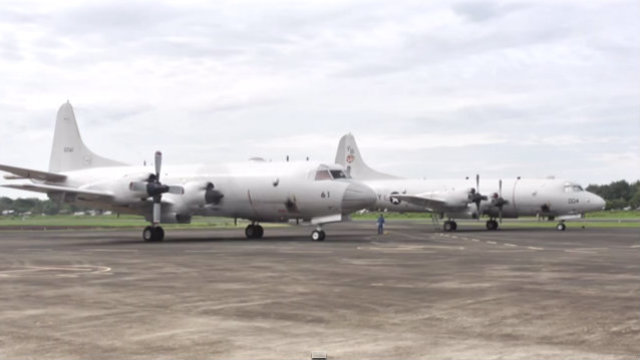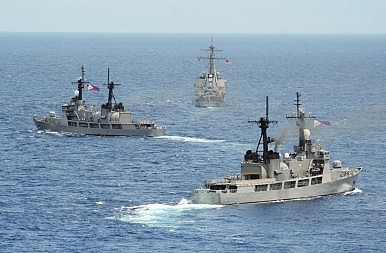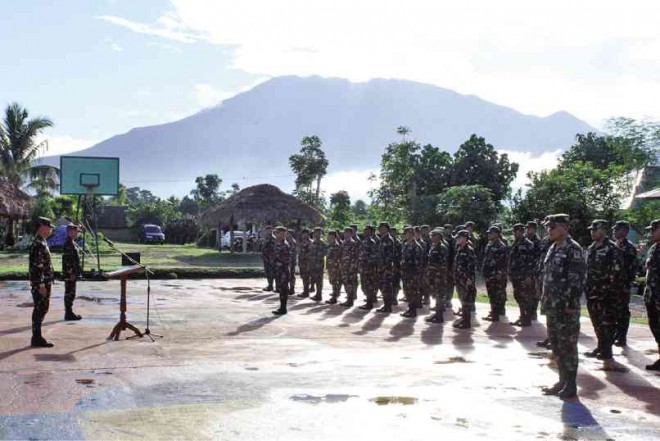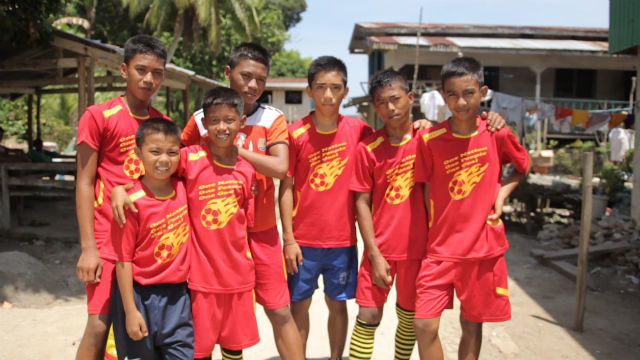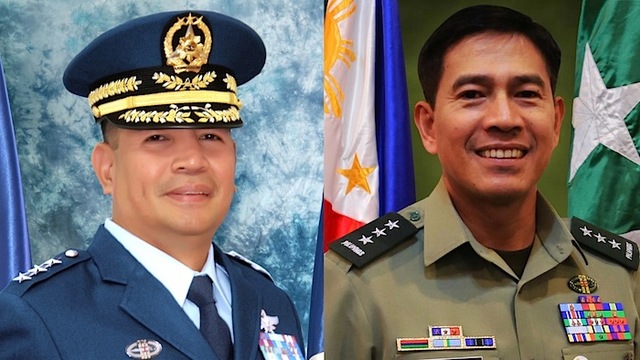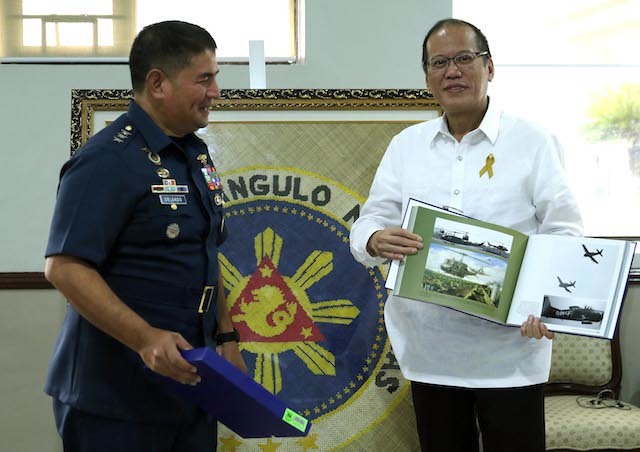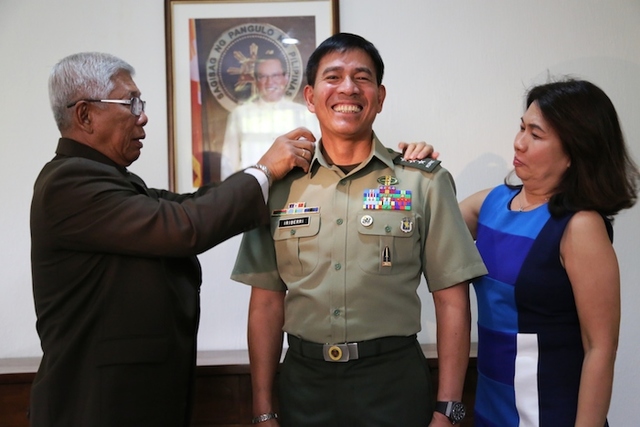From Rappler (Jul 8):
FULL TEXT: The Philippines' opening salvo at The Hague
 TOP DIPLOMAT. Philippine Foreign Secretary Albert del Rosario gives a statement about the South China Sea during a news conference in Manila on March 30, 2014. File photo by Noel Celis/AFP
Below is the full text of Philippine Foreign Secretary Albert del Rosario's statement before an arbitral tribunal at The Hague, The Netherlands, on the Philippines' case against China. Del Rosario delivered this speech – originally titled "Why the Philippines Brought This Case to Arbitration and Its Importance to the Region and the World" – on July 7, the first day of oral hearings at The Hague.
TOP DIPLOMAT. Philippine Foreign Secretary Albert del Rosario gives a statement about the South China Sea during a news conference in Manila on March 30, 2014. File photo by Noel Celis/AFP
Below is the full text of Philippine Foreign Secretary Albert del Rosario's statement before an arbitral tribunal at The Hague, The Netherlands, on the Philippines' case against China. Del Rosario delivered this speech – originally titled "Why the Philippines Brought This Case to Arbitration and Its Importance to the Region and the World" – on July 7, the first day of oral hearings at The Hague.
1. Mr President,
distinguished Members of the Tribunal, it is a great honor to respectfully
appear before you on behalf of my country, the Republic of the Philippines. It
is indeed a special privilege to do so in a case that has such importance to
all Filipinos and – if I may add – to the rule of law in international
relations.
2. Mr President,
the Philippines
has long placed its faith in the rules and institutions that the international
community has created to regulate relations among States. We are proud to have
been a founding member of the United Nations, and an active participant in that
indispensable institution.
3. Its organs,
coupled with the power of international law, serve as the great equalizer among
States, allowing countries, such as my own, to stand on an equal footing with
wealthier, more powerful States.
4. Nowhere is
this more true, Mr President, than with respect to the progressive development
of the law of the sea, which culminated in the adoption of the Law of the Sea
Convention in 1982. That instrument, which has rightly been called a
“Constitution for the Oceans,” counts among its most important achievements the
establishment of clear rules regarding the peaceful use of the seas, freedom of
navigation, protection of the maritime environment and, perhaps most
importantly, clearly defined limits on the maritime areas in which States are
entitled to exercise sovereign rights and jurisdiction.
5. These are all
matters of central significance to the Philippines. Indeed, given our
lengthy coastline, our status as an archipelagic state, and our seafaring
tradition, the rules codified in the law of the sea have always had particular
importance for the Philippines.
The Philippines
is justifiably proud of the fact that it signed the Convention on the day it
was opened for signature, on December 10, 1982, and was one of the first States
to submit its instrument of ratification, which it did on May 8, 1984.
6. The Philippines has
respected and implemented its rights and obligations under the Convention in
good faith. This can be seen in the amendment of our national legislation to
bring the Philippines’ maritime claims into compliance with the Convention, by
converting our prior straight baselines into archipelagic baselines in
conformity with Articles 46 and 47, and by providing that the maritime zones of
the Kalayaan Island Group and Scarborough Shoal in the South China Sea would be
consistent with Article 121.
7. The Philippines
took these important steps, Mr President, because we understand, and accept,
that compliance with the rules of the Convention is required of all States
Parties.
8. I mentioned a
moment ago the equalizing power of international law. Perhaps no provisions of
the Convention are as vital to achieving this critical objective than Part XV.
It is these dispute resolution provisions that allow the weak to challenge the
powerful on an equal footing, confident in the conviction that principles trump
power; that law triumphs over force; and that right prevails over might.
9. Mr President,
allow me to respectfully make it clear: in submitting this case, the Philippines is NOT asking the Tribunal to
rule on the territorial sovereignty aspect of its disputes with China.
10. We are here
because we wish to clarify our maritime entitlements in the South
China Sea, a question over which the Tribunal has jurisdiction.
This is a matter that is most important not only to the Philippines, but also to all coastal States that
border the South China Sea, and even to all
the States Parties to UNCLOS. It is a dispute that goes to the very heart of
UNCLOS itself. Our very able counsel will have much more to say about this
legal dispute over the interpretation of the Convention during the course of
these oral hearings. But in my humble layman’s view, the central legal dispute
in this case can be expressed as follows:
11. For the Philippines,
the maritime entitlements of coastal States – to a territorial sea, exclusive
economic zone, and continental shelf, and the rights and obligations of the
States Parties within these respective zones – are established, defined, and
limited by the express terms of the Convention. Those express terms do not
allow for – in fact they preclude – claims to broader entitlements, or
sovereign rights, or jurisdiction, over maritime areas beyond the limits of the
EEZ or continental shelf. In particular, the Convention does not recognize, or
permit the exercise of, so-called “historic rights” in areas beyond the limits
of the maritime zones that are recognized or established by UNCLOS.
12. Sadly, China disputes
this, Mr President, in both word and deed. It claims that it is entitled to
exercise sovereign rights and jurisdiction, including the exclusive right to
the resources of the sea and seabed, far beyond the limits established by the
Convention, based on so-called “historic rights” to these areas. Whether these
alleged “historic rights” extend to the limits generally established by China’s
so-called “9-dash line,” as appears to be China’s claim, or whether they
encompass a greater or a narrower portion of the South China Sea, the
indisputable fact, and the central element of the legal dispute between the
Parties, is that China has asserted a claim of “historic rights” to vast areas
of the sea and seabed that lie far beyond the limits of its EEZ and continental
shelf entitlements under the Convention.
13. In fact, China has done
much more, Mr President, than to simply claim these alleged “historic rights.”
It has acted forcefully to assert them, by exploiting the living and non-living
resources in the areas beyond the UNCLOS limits while forcibly preventing other
coastal States, including the Philippines, from exploiting the resources in the
same areas – even though the areas lie well within 200 M of the Philippines’
coast and, in many cases, hundreds of miles beyond any EEZ or continental shelf
that China could plausibly claim under the Convention.
14. The legal
dispute between the Philippines
and China over China’s claim to and exercise of alleged
“historic rights” is a matter falling under the Convention, and particularly
Part XV, regardless of whether China
is claiming that “historic rights” are recognized under the Convention, or
allowable under the Convention because they are not precluded by it. China has made
both arguments in its public statements. But it makes no difference for
purposes of the characterization of this dispute as one calling for the
interpretation or application of the Convention. The question raised by the
conflicting positions of the Philippines
and China
boils down to this: Are maritime entitlements to be governed strictly by
UNCLOS, thus precluding claims of maritime entitlements based on “historic
rights”? Or does the UNCLOS allow a State to claim entitlements based on
“historic” or other rights even beyond those provided for in the Convention
itself?
15. As our
counsel will explain, Mr President, any recognition of such “historic rights”
conflicts with the very character of UNCLOS and its express provisions
concerning the maritime entitlements of coastal States. This calls indisputably
for the proper interpretation of the fundamental nature of the Convention.
16. China’s assertion and exercise of its alleged
rights in areas beyond its entitlements under UNCLOS have created significant
uncertainty and instability in our relations with China and in the broader region. In
this respect, I note the presence here today of representatives of Vietnam, Malaysia,
Indonesia, Thailand, and Japan to observe these critical
proceedings.
17. Mr President, China has claimed “historic rights” in areas
that are beyond 200 M from its mainland coasts, or any land feature over which
it claims sovereignty, and within 200 M of the coasts of the Philippines’ main islands, and exploited the
resources in these areas while preventing the Philippines from doing so. It has
therefore, in the Philippines’
view, breached the Convention by violating Philippine sovereign rights and
jurisdiction. China
has pursued its activities in these disputed maritime areas with overwhelming
force. The Philippines
can only counter by invoking international law. That is why it is of
fundamental importance to the Philippines, and we would submit, for the rule of
law in general, for the Tribunal to decide where and to what limit China has
maritime entitlements in the South China Sea; where and to what limit the
Philippines has maritime entitlements; where and to what extent the Parties’
respective entitlements overlap and where they do not. None of this requires or
even invites the Tribunal to make any determinations on questions of land
sovereignty, or delimitation of maritime boundaries.
18. The Philippines
understands that the jurisdiction of this tribunal convened under UNCLOS is
limited to questions that concern the law of the sea. With this in mind, we
have taken great care to place before you only claims that arise directly under
the Convention. As counsel for the Philippines will discuss at length
in the coming days, we have, in essence, presented five (5) principal claims.
They are:
– First, that China is not
entitled to exercise what it refers to as “historic rights” over the waters,
seabed, and subsoil beyond the limits of its entitlements under the Convention;
– Second, that the
so-called 9-dash line has no basis whatsoever under international law insofar
as it purports to define the limits of China’s claim to “historic rights”;
– Third, that the
various maritime features relied upon by China as a basis upon which to assert
its claims in the South China Sea are not islands that generate entitlement to
an exclusive economic zone or continental shelf. Rather, some are “rocks”
within the meaning of Article 121, paragraph 3; others are low-tide elevations;
and still others are permanently submerged. As a result, none are capable of
generating entitlements beyond 12M, and some generate no entitlements at all. China’s recent
massive reclamation activities cannot lawfully change the original nature and
character of these features;
– Fourth, that China has breached the Convention by interfering
with the Philippines’
exercise of its sovereign rights and jurisdiction; and
– Fifth, that China has irreversibly damaged the regional
marine environment, in breach of UNCLOS, by its destruction of coral reefs in
the South China Sea, including areas within the Philippines’ EEZ, by its
destructive and hazardous fishing practices, and by its harvesting of
endangered species.
19. Mr President,
the Philippines is committed
to resolving its disputes with China
peacefully and in accordance with international law. For over two decades, we
diligently pursued that objective bilaterally, regionally, and multilaterally.
I will not here take this Tribunal through the Philippines’ painstaking and
exhaustive diplomatic efforts, which are set out in detail in our written
pleadings. I will, however, mention a few representative examples, if I may.
20. As far back
as August 1995, after China seized and built structures on Mischief Reef – a
low-tide elevation located 126 nautical miles from the Philippine island of
Palawan and more than 600 nautical miles from the closest point on China’s
Hainan Island – the Philippines sought to address China’s violation of its
maritime rights diplomatically. During those exchanges, the Philippines and
China agreed that the dispute should be resolved in accordance with UNCLOS. As
the then Chinese Vice Minister for Foreign Affairs, Mr Tang Jiaxuan, stated two
years later during bilateral negotiations, China and the Philippines should
“approach the disputes on the basis of international law, including the United
Nations Convention on the Law of the Sea, particularly its provisions on the
maritime regimes like the exclusive economic zone.”
21. The mutual
acceptance that the Philippines’ disputes with China must be resolved in
accordance with UNCLOS was also reflected in a Joint
Communiqué issued in July 1998 upon completion of bilateral
discussions between my predecessor, Foreign Secretary Domingo Siazon, and
China’s Foreign Minister Tang Jiaxuan. The Communiqué recorded that, and I
quote, “The two sides exchanged views on the question of the South China Sea
and reaffirmed their commitment that the relevant disputes shall be settled
peacefully in accordance with the established principles of international law,
including the United Nations Convention on the Law of the Sea.” (End of quote)
22. Regrettably,
neither the bilateral exchanges I have mentioned, nor any of the great many
subsequent exchanges, proved capable of resolving the impasse caused by China’s
intransigent insistence that China alone possesses maritime rights in virtually
the entirety of the South China Sea, and that the Philippines must recognize
and accept China’s sovereignty before meaningful discussion of other issues
could take place.
23. The
Philippines has also been persistent in seeking a diplomatic solution under the
auspices of ASEAN. This has proven no more successful than our bilateral
efforts. In fact, China has insisted that ASEAN cannot be used to resolve any
territorial or maritime disputes concerning the South China Sea, and that such
issues can only be dealt with in bilateral negotiations. ASEAN and China have
yet to conclude a binding code of conduct in the South China Sea. The most that
has been achieved was the issuance, in 2002, of a “Declaration on the Conduct
of Parties in the South China Sea.” Although that document recorded the
parties’ commitment to work toward the “eventual” establishment of a code of
conduct in the South China Sea, China’s intransigence in the 13 years of
subsequent multilateral negotiations has made that goal nearly unattainable.
24. Nonetheless,
Mr President, the 2002 DOC is significant in at least one important respect:
the ASEAN Member States and China undertook therein to “resolve their territorial
and jurisdictional disputes by peaceful means, without resorting to the threat
or use of force, through friendly consultations and negotiations by sovereign
states directly concerned, in accordance with universally recognized principles
of international law, including the 1982 UN
Convention on the Law of the Sea.” In so doing, the Declaration
encouraged those States, should they prove unable to resolve their disputes
through consultations or negotiations, to do so in accordance with the
Convention, which includes, of course, the dispute resolution procedures under
Part XV.
25. Mr President,
over the years, China’s positions and behavior have become progressively more
aggressive and disconcerting. Outside observers have referred to this as
China’s “salami-slicing” strategy: that is, taking little steps
over time, none of which individually is enough to provoke a crisis. Chinese
military officials themselves have referred to this as its “cabbage” strategy:
peeling one layer off at a time. When these small steps are taken together,
however, they reflect China’s efforts to slowly consolidate de facto control throughout the South China
Sea.
26. Two more
recent incremental steps caused the Philippines to conclude that it had no
alternative other than to invoke compulsory procedures entailing a binding
decision. The first was China’s transmittal of its 9-dash line claim to the
United Nations in 2009, after which, it prevented the Philippines from carrying
out long-standing oil and gas development projects in areas that are well
inside the Philippines’ 200 M EEZ and continental shelf.
27. Secondly, in
2012, China forcibly expelled Philippine fishermen from the maritime
areas around Scarborough Shoal where the Filipino fishermen have for
generations been fishing without so much as a protest from China.
28. These and
other acts by China caused the Philippines to conclude that continued
diplomatic efforts, whether bilateral or multilateral, would be futile, and
that the only way to resolve our maritime disputes was to commence the present
arbitration.
29. Subsequent
events, including China’s acceleration of massive land reclamation activities,
which it has undertaken – and continues to undertake – in blatant disregard of
the Philippines rights’ in its EEZ and continental shelf, and at tremendous cost to the marine environment in violation of UNCLOS –
only serve to reconfirm the need for judicial intervention.
30. Mr President,
I would like to conclude by conveying my country’s deepest appreciation for the
considerable time and attention you have devoted to these proceedings. The case
before you is of the utmost importance to the Philippines, to the region, and
to the world. In our view, it is also of utmost significance to the integrity
of the Convention, and to the very fabric of the “legal order for the seas and
oceans” that the international community so painstakingly crafted over many
years.
31. If China can
defy the limits placed by the Convention on its maritime entitlements in the
South China Sea, and disregard the entitlements of the Philippines under the
Convention, then what value is there in the Convention for small States Parties
as regards their bigger, more powerful and better armed neighbors? Can the
Philippines not invoke Part XV to challenge China’s activities as violations of
its obligations and the Philippines’ rights, considering that the Philippines’
claims call for a mere interpretation and application of the Convention and do
not fall within any of the jurisdictional exclusions of Articles 297 or 298?
32. Mr President,
if the Philippines cannot invoke Part XV, then what remains of the obligation
regarding judicial settlement of disputes that was such a key element of the
comprehensive package that made the Convention acceptable to all State Parties?
33. We
understand, Mr President, that in the exercise of its collective wisdom and
judgment, this body has decided to bifurcate the proceedings and to limit these
current hearings to the issue of jurisdiction. In this respect, we shall
explain in full how our case falls squarely within the jurisdiction of this
Tribunal, to the end that justice and fair play may prevail and the Tribunal
would recognize its jurisdiction over the case and allow the Philippines to
present the actual merits of our position.
34. In the
Philippines’ view, it is not just the Philippines’ claims against China that
rest in your capable hands. Mr. President, it is the spirit of UNCLOS itself.
That is why, we submit, these proceedings have attracted so much interest and
attention. We call on the Tribunal to kindly uphold the Convention and enable
the rule of law to prevail.
35. I humbly
thank you, Mr President, and distinguished Members of the Tribunal. May I now
ask that Philippines’ counsel, Mr. Paul Reichler, be called to the podium.
http://www.rappler.com/nation/98769-philippines-china-hague-opening-statement-full-text
